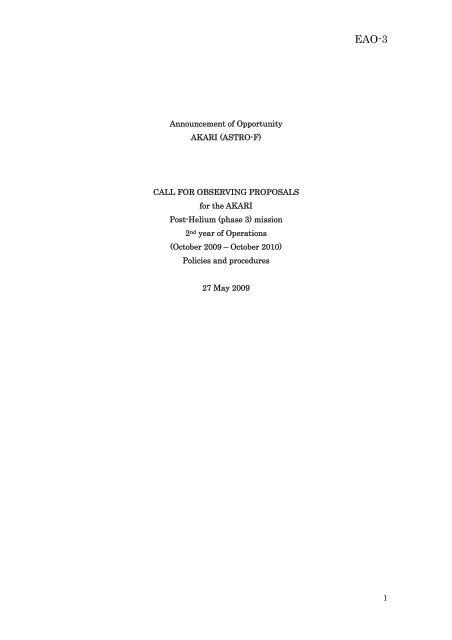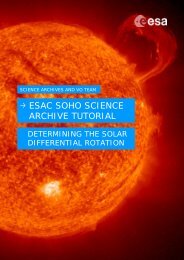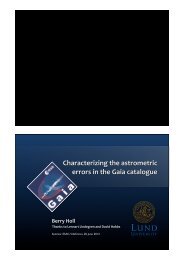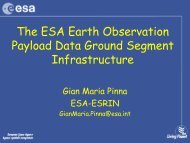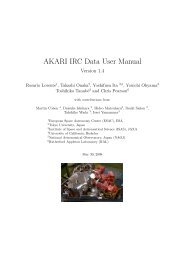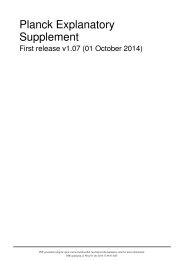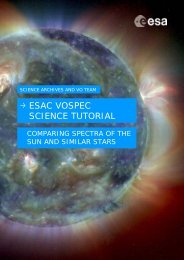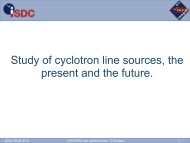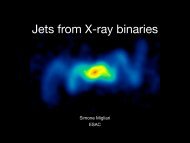1 Announcement of Opportunity AKARI (ASTRO-F) CALL FOR ... - ESA
1 Announcement of Opportunity AKARI (ASTRO-F) CALL FOR ... - ESA
1 Announcement of Opportunity AKARI (ASTRO-F) CALL FOR ... - ESA
- No tags were found...
You also want an ePaper? Increase the reach of your titles
YUMPU automatically turns print PDFs into web optimized ePapers that Google loves.
EAO-3<strong>Announcement</strong> <strong>of</strong> <strong>Opportunity</strong><strong>AKARI</strong> (<strong>ASTRO</strong>-F)<strong>CALL</strong> <strong>FOR</strong> OBSERVING PROPOSALSfor the <strong>AKARI</strong>Post-Helium (phase 3) mission2 nd year <strong>of</strong> Operations(October 2009 – October 2010)Policies and procedures27 May 20091
EAO-3CHANGE LOGReason for change Page DateNew document 27 May 20092
EAO-3TABLE OF CONTENTS1. Overview .......................................................................................................................42. The <strong>AKARI</strong> Mission ......................................................................................................43. Mission phases and time allocation .............................................................................54. Observing constraints...................................................................................................75. Review process and schedule .......................................................................................86. Data products and data rights .....................................................................................97. Proposal submission .....................................................................................................98. Documentation and Tools ...........................................................................................103
EAO-31. OverviewThis is an announcement soliciting proposals for participation in the <strong>ESA</strong> <strong>AKARI</strong>(<strong>ASTRO</strong>-F) Open Time programme in the post-helium phase (Phase 3) <strong>of</strong> the mission,for the 2 nd year <strong>of</strong> operations (October 2009 – October 2010). <strong>AKARI</strong> is an infrared spacemission <strong>of</strong> the Institute <strong>of</strong> Space and Astronautical Science (ISAS), Japan AerospaceExploration Agency (JAXA). A portion <strong>of</strong> the observing time is reserved for scientistsbelonging to institutions within the <strong>ESA</strong> member states.This document presents an overview <strong>of</strong> the <strong>AKARI</strong> mission, an introduction <strong>of</strong> theobserving opportunities with <strong>AKARI</strong> in the post-helium phase, the policies adopted andthe procedures to be followed for proposal submission.Detailed documentation about the mission and tools for proposal submissions areavailable at the <strong>ESA</strong> site:http://akari.esac.esa.int/Japanese and Korean scientists should consult the parallel announcement at:http://www.ir.isas.jaxa.jp/<strong>AKARI</strong>/Observation/2. The <strong>AKARI</strong> Mission<strong>AKARI</strong> is the first Japanese space mission dedicated to infrared astronomy. A majorgoal <strong>of</strong> the mission was to perform an All-Sky Survey in six infrared bands between 6and 180 micron. <strong>AKARI</strong> also performed pointed observations over the wavelength range2-180 microns in 13 bands, providing comprehensive multi-wavelength photometric andspectroscopic coverage <strong>of</strong> a wide variety <strong>of</strong> astronomical sources.<strong>AKARI</strong> was launched on February 21 (UT), 2006 and brought into a sun-synchronousorbit at an altitude <strong>of</strong> 700 km with a period <strong>of</strong> approximately 100 min by a JAXA M-Vrocket. The telescope system and the scientific instruments on board were cooled downby super-fluid liquid helium with mechanical coolers. <strong>AKARI</strong> cryogen boiled <strong>of</strong>f on 26August 2007, 550 days after launch as predicted. The telescope system is currently keptat about 45K by means <strong>of</strong> the mechanical cooler and observations at near infrared4
EAO-3wavelengths can continue. <strong>AKARI</strong> is equipped with a 68.5 cm cooled telescope and twoscientific instruments, the Far-Infrared Surveyor (FIS) and the Infrared Camera (IRC).The FIS has two 2-dimensional detector arrays and observes in four far-infrared bandsbetween 50 and 180 µm. The IRC consists <strong>of</strong> three cameras covering 1.8 - 26 µm with afield-<strong>of</strong>-view <strong>of</strong> approximately 10 × 10 arcminutes 2 . Both instruments have low tomoderate resolution spectroscopic capabilities. Only the IRC near infrared channel (1.8µm – 5.5 µm) is available for Phase 3 observations. The <strong>AKARI</strong> near-infraredspectroscopic capability is unique at present, enabling to quickly obtain completespectra <strong>of</strong> faint sources (down to about 1 mJy) without terrestrial atmospheredisturbances. The spacecraft spins about the sun-pointed axis once per orbit, pointingthe telescope at the zenith. In this scanning mode, an all-sky survey was executed inthe cold phase simultaneously both with the FIS and IRC. Up to three times per orbit,the attitude <strong>of</strong> the spacecraft was fixed in the inertial space for up to approximately600s to make a pointed observation with the FIS or IRC. In the pointed observationmode, the absolute pointing accuracy is better than 30 arcsec and the attitude stabilityis 1 arcsec per minute. In the post-helium phase, the All-sky survey is not carried out(being defined at mid and far infrared wavelengths). The pointing configurationsremain unchanged however as for the cold phase.The <strong>AKARI</strong> project is run by JAXA’s Institute <strong>of</strong> Space and Astronautical Science (ISAS)in Japan in collaboration with other Japanese institutions, Seoul National University inKorea, Imperial College London, the Open University, University <strong>of</strong> Sussex in theUnited Kingdom, the Netherlands Institute for Space Research (SRON) with theKapteyn Astronomical Institute in the Netherlands, and the European Space Agency(<strong>ESA</strong>).3. Mission phases and time allocationThe observing programme is conceived along three phases:• Phase 1 comprised the first 6 months after the Performance Verification phase,in which the All-Sky Survey was the primary program. Pointed observationswere also preformed in this phase for the <strong>AKARI</strong> project team.• Phase 2 encompassed the period after Phase 1 until liquid helium exhaustion.It lasted 291 days, until the liquid helium boiled-<strong>of</strong>f on August 26, 2007.During Phase 2, the area that could not be observed for the survey in Phase 1was observed in the scanning mode to complete the All-Sky Survey. In the rest5
EAO-3<strong>of</strong> observing time, 4000 pointed observations were executed.• In Phase 3 the telescope and scientific instruments are kept around 45K by themechanical cooler and only near-infrared observations in the pointedobservation mode are carried out.This Call <strong>of</strong>fers observing opportunities in Phase 3 for the 2 nd year <strong>of</strong> operations. Of thetotal observing time, 10% is reserved for calibration and director’s time. <strong>AKARI</strong> willcarry out scientific observations in the remaining 90%. The <strong>AKARI</strong> team has its ownobserving programs, called “Mission Program (MP)”. MP is a coherent set <strong>of</strong>guaranteed time programs dedicated to specific scientific goals. It comprises 15programs. In Phase 3, 60% <strong>of</strong> the total pointed observations are allocated to MPs. Theremaining 30% are open to General Observers (hereafter Open Time observations; OT).One third <strong>of</strong> the OT will be allocated to the European astronomers through <strong>ESA</strong> as part<strong>of</strong> an internal collaboration (hereafter <strong>ESA</strong> OT). The remaining two thirds will beassigned to observation opportunities for the Japanese and Korean communities(hereafter ISAS OT). About 1400 pointed observation opportunities are anticipated tobe available for the ISAS OT observations and 700 for the <strong>ESA</strong> OT.In Phase 1 and 2, the observing opportunities were distributed in a similar manner. Inaddition to the MPs, the <strong>AKARI</strong> team had developed and executed pointed observationsurveys on specific areas <strong>of</strong> the sky, namely the North Ecliptic Pole and the LargeMagellanic Cloud.A Call for observations in Phase 2 was issued in September 2005. 50 proposals werereceived at <strong>ESA</strong> and 49 in ISAS. Seventeen proposals were granted observing time bythe European TAC (26 by the Japanese and Korean TAC). Four hundred Europeanobservations were executed in the cold phase, i.e. 10% <strong>of</strong> the available pointingopportunities.A Call for observations in Phase 3 for the 1 st year <strong>of</strong> operations was issued on 12 May2008. 12 proposals were received at <strong>ESA</strong> and 28 at ISAS. 11 proposals were grantedobserving time by the <strong>ESA</strong> appointed TAC and 22 by the Japanese and Korean TAC. Atthe time <strong>of</strong> writing, over 460 European observations and 900 Japanese and Koreanobservations have been successfully executed, in line with the overall schedulingsimulation. By the end <strong>of</strong> the 1 st year <strong>of</strong> operation, ~700 European observations and1300 Japanese and Korean observations are expected to have been executed as planned.6
EAO-34. Observing constraintsBecause the <strong>AKARI</strong> telescope has to avoid the Sun- and Earthshine in its low Earthorbit, the sky visibility is highly restricted. Particularly, objects near the ecliptic planehave a small chance <strong>of</strong> being observed. Except for the ecliptic polar regions, severalpointed observations <strong>of</strong> a given target are thus quite difficult. The attitude controlsystem has a capability to locate the telescope axis ±1 degree <strong>of</strong>f the canonical position<strong>of</strong> the solar elongation <strong>of</strong> 90 degree, which increases the observable area on a given orbit.<strong>AKARI</strong> is operated in a pre-planned manner without any significant routine real-timeinteraction. Thus, all observations must be specified in full detail by the observerswith pre-packaged templates or AOTs (Astronomical Observations Templates). Opentime proposers may apply to use any <strong>of</strong> the instrument modes or AOTs described in theObserver’s manual.In general, OT investigators should not propose observations that are deemed toduplicate those targets scheduled in MPs. Since both instruments have arraydetectors, a guideline <strong>of</strong> the definition <strong>of</strong> a duplication observation is to overlap withhalf <strong>of</strong> the field-<strong>of</strong>-view <strong>of</strong> existing MP targets with the same AOT. Those with arequested number <strong>of</strong> pointings a factor <strong>of</strong> 4 higher are not regarded as duplications.However as described above, such observations may only be possible in very smallregions <strong>of</strong> the entire sky.It is not recommended (although not prohibited) to repeat observations alreadyexecuted in the cold phase, or in the first year <strong>of</strong> warm phase with the same AOT.Observers should justify the repetition <strong>of</strong> those observations in the proposal. All IRCobservations executed in Phase 1 and 2 are in the public domain.A tool is provided, returning observations deemed to duplicate Phase 3 MP orobservations in the cold phase or the first year <strong>of</strong> warm phase, performed with the sameAOT. In addition, observers are invited to consult the observing log for possible overlapwith executed observations in the Phase 3 PV phase. The latter set may be duplicated,although users are aware that these are by definition in the public domain already.In making MP observing programs, 6 orbits in two days are reserved for OT observationopportunities. Taking account <strong>of</strong> the ±1 degree pointing capability <strong>of</strong>f the canonicalattitude, any part <strong>of</strong> the sky should be observable in OT observations in the reservedorbits, except for the areas disturbed by the presence <strong>of</strong> the Moon, and the South7
EAO-3Atlantic Anomaly (SAA) where a high hit rate <strong>of</strong> ionizing particles are anticipated.Note, however, that targets near the ecliptic plane generally have a small number <strong>of</strong>observation opportunities. Observers should understand that opportunities to observeparticular objects or fields with <strong>AKARI</strong> are severely limited. Observations <strong>of</strong> generictargets distributed over the entire sky are preferred to those <strong>of</strong> specific targets. Timecritical observations are not recommended for the same reasons. Target-<strong>of</strong>-opportunity(TOO) proposals will not be accepted as OT proposals. They can instead be requestedas director’s time. An Open Time proposal should have a sufficient number <strong>of</strong> backuptargets (priority C) in addition to those with A and B priorities. The targets should bedistributed across priorities A:B:C in the ratio <strong>of</strong> 1:1:1.Because <strong>of</strong> the increased number <strong>of</strong> hot pixels, observers should take account <strong>of</strong> this factseriously and are strongly recommended to have sufficient redundancy in theirobservation plan. Particularly deep imaging (IRCZ0) and spectroscopy (IRCZ4) shouldhave at least 3 pointing observations for the same target. Refer to the Observer’smanual for phase 3 (version 1.2) for details <strong>of</strong> the instrument performance.5. Review process and scheduleProposals may be submitted until 6 July 2009. All proposals will first be technicallyassessed by the User Support Team at <strong>ESA</strong>C, who will also prepare summary statisticson the response. The proposals will then be sent to an <strong>ESA</strong> established European TimeAllocation Committee for peer review. <strong>ESA</strong> and ISAS will make the reviewindependently. The following items will be taken into account during the reviewprocess:• Scientific case and justification• Scientific merit and relevance <strong>of</strong> the proposed observation(s)• Exploitation <strong>of</strong> the <strong>AKARI</strong> instrument• Duplication with MP observations and with observations already executed in thecold phase• Technical feasibility and adequate performance estimation• Visibility and requested number <strong>of</strong> pointingsThe final selection <strong>of</strong> the proposals will be made based on the results <strong>of</strong> both reviews. Incase <strong>of</strong> conflict, the proposal with the higher ranking in the individual lists will beselected. If there are similar proposals with similar evaluation in both sides,8
EAO-3corresponding investigators may be asked to make collaborative observations. Thevisibility <strong>of</strong> the proposed observations will be examined before the selection to ensurethat they can be allocated the requested observing time. The result <strong>of</strong> this process isexpected to be announced to the proposers in September 2009. Successful proposers willbe given the number <strong>of</strong> pointed observations <strong>of</strong> each priority and asked to revise thetarget list, if necessary, to meet the given observation opportunities.The observation scheduling will be performed as follows: priority A observations will bescheduled first, followed by B and C observations. In general, observations withpriority C will not be executed even if observing time is allocated. Investigators <strong>of</strong>successful proposals will be informed which A and B observations are allocated theobserving time and asked to report which C observations should replace unallocated Aand B observations. Investigators should understand that the execution <strong>of</strong> theallocated observations cannot be guaranteed.6. Data products and data rightsThe data will be delivered to the successful proposer after standard processing has beenperformed. The data package will comprise both raw and pipeline-processed datatogether with the associated calibration files. Open Time data have a proprietaryperiod <strong>of</strong> one year since their availability in the Data Archive.7. Proposal submissiona) Who may propose. Only PIs affiliated with institutions located in <strong>ESA</strong>member states are eligible to propose for <strong>AKARI</strong> Open Time programmethrough <strong>ESA</strong>. This requirement does not extend to Co-Investigators.b) Due date <strong>of</strong> proposals. Proposals are due on 6 July, 2009, 09:00 hrs UT.In view <strong>of</strong> possible network congestion close to the deadline, proposers areurged to submit their proposals well in advance <strong>of</strong> the due date.c) Proposal format. Proposals must be submitted electronically using theProposal Submission Tool available at the <strong>AKARI</strong> websitehttp://akari.esac.esa.int/. Details <strong>of</strong> the mission, instruments and observingmodes (AOTs) are provided in the Observers Manual documentation.Observers are required to check the visibility and the technical feasibility <strong>of</strong>the observations, and the duplication with blocked observations, via usage9
EAO-3<strong>of</strong> the specific tools provided. Proposals should include a scientificjustification for the program and a demonstration <strong>of</strong> the feasibility <strong>of</strong> theproposed observations and the need <strong>of</strong> the unique capabilities <strong>of</strong> <strong>AKARI</strong> forcarrying out the investigation. The scientific justification is limited to 6pages at most (4 for text and 2 for figures and tables). A latex template isprovided. The proposal will include the complete target list and associatedobservation details.8. Documentation and ToolsThe following documentation and tools are available at http://akari.esac.esa.int/• Letter from <strong>ESA</strong> Director <strong>of</strong> ScienceThe formal invitation letter from the Director <strong>of</strong> the <strong>ESA</strong> Scientific Programme• The <strong>ESA</strong> <strong>AKARI</strong> <strong>Announcement</strong> <strong>of</strong> <strong>Opportunity</strong>This document, providing the necessary information about the policies adoptedand the procedures to be followed.• <strong>AKARI</strong> Observers’ FactsheetA synoptic 2-pages overview <strong>of</strong> the mission and instrument capabilities,sensitivities and observing modes (AOTs).• <strong>AKARI</strong> Observer’s manual for the post-Helium (Phase 3) mission.A document which describes the mission scientific instrument and AOTs,including its performance, and the guidelines for the observation planning.• Mission Program (MP) abstracts for Phase 3The following items will be available in mid June:• Blocked target list• Target list format validity check toolA web tool to check the validity <strong>of</strong> a target list (this module is also integrated inthe other tools).• Duplication check toolA web tool to search for nearby targets in the blocked target list.• Visibility toolA web tool to provide the target visibility.• Proposal Submission ToolA web tool for the submission <strong>of</strong> the proposal and the target list.10
EAO-3For any question regarding Open Time observations, please consult with the <strong>ESA</strong><strong>AKARI</strong> helpdesk at http://akari.esac.esa.int/esupport/11


